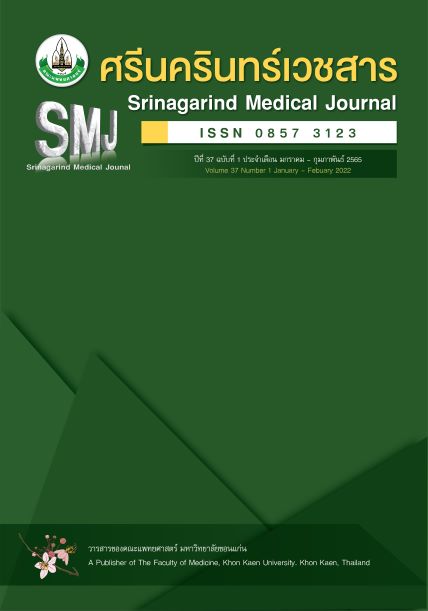อัตรารอดชีพผู้ป่วยไตวายเรื้อรังระยะสุดท้ายที่ได้รับการบำบัดทดแทนไต ของโรงพยาบาล ยางตลาด จังหวัดกาฬสินธุ์
Abstract
Survival Rates for Patients with End-stage Renal Disease Receiving Renal Replacement Therapy at Yang Talat Hospital, Kalasin Province, Thailand
หลักการและวัตถุประสงค์: ผู้ป่วยโรคไตวายเรื้อรังระยะสุดท้ายโดยเฉพาะในจังหวัดกาฬสินธุ์มีแนวโน้มเพิ่มสูงขึ้นจึงทำให้ผู้ป่วยได้รับการรักษาโดยวิธีการบำบัดทดแทนไต งานวิจัยนี้จึงมีวัตถุประสงค์เพื่อศึกษาเปรียบเทียบและอัตรารอดชีพผู้ป่วยไตวายเรื้อรังระยะสุดท้ายที่ได้รับการบำบัดทดแทนไตโดยวิธีล้างไตทาง
ช่องท้องและการฟอกเลือดด้วยเครื่องไตเทียม ของโรงพยาบาลยางตลาด จังหวัดกาฬสินธุ์
วิธีการศึกษา : แบบ Retrospective cohort study โดยใช้ฐานขอมูลผู้ป่วยจากระบบสารสนเทศโรงพยาบาล
ยางตลาด ระหว่าง 1 สิงหาคม 2553 ถึง 31 ธันวาคม 2560 ด้วยวิธีการติดตามผู้ป่วยทุกรายเพื่อให้ได้ข้อมูลสถานะสุดท้ายการมีชีวิตจนถึง 31 ธันวาคม 2563 ด้วยการวิเคราะห์อัตรารอดชีพ จำนวน 196 ราย โดย วิธี Kaplan-Meier สถิติทดสอบโดย Log-rank test และทดสอบปัจจัยเสี่ยงโดยใช้สถิติ Cox regression
ผลการศึกษา: ผู้ป่วยไตวายเรื้อรังระยะสุดท้ายที่ได้รับการบำบัดทดแทนไตโดยวิธีการล้างไตทางช่องท้อง
มีโอกาสเสี่ยงต่อการตายเป็น 1.93 เท่า เมื่อเทียบกับผู้ป่วยไตวายเรื้อรังระยะสุดท้ายที่ได้รับการบำบัดทดแทนไตโดยวิธีฟอกเลือดด้วยเครื่องไตเทียม (Adjusted HR=1.93; 95% CI; 1.09 – 3.39, p= 0.021) อัตราการรอดชีพในระยะเวลา 1,3 และ 5 ปี ของผู้ป่วยไตวายเรื้อรังระยะสุดท้ายที่ได้รับการบำบัดทดแทนไตโดยวิธี HD เท่ากับ
ร้อยละ 92.7 ,82.7 และ 68.7 วิธี CAPD เท่ากับ ร้อยละ 88.6 ,63.4 และ 47.8
สรุป: วิธีการบำบัดทดแทนไตโดยวิธีล้างไตทางช่องท้องมีโอกาสเสี่ยงต่อการตายมากกว่าวิธีฟอกเลือดด้วยเครื่องไตเทียม
คำสำคัญ: ผู้ป่วยไตวายเรื้อรังระยะสุดท้าย, การล้างไตทางช่องท้อง,การฟอกเลือดด้วยเครื่องไตเทียม, อัตราการรอดชีพ
Background and Objective: Numbers of patients with end-stage renal disease are increasing , especially in Kalasin Province. This study analyzed patient data from Health Information System to compare survival rates of end-stage renal failure patients receiving renal replacement therapy at Yang Talat Hospital.
Method: This was a retrospective cohort study using the chronic renal failure medical record database at Yang Talat Hospital's hemodialysis clinic, for patients registered between August 1st, 2010 and December 31st, 2017. All 196 patients were then followed up until 31st December 2020. Survival rates were analyzed by the Kaplan-Meier method. The log-rank test was used to compare survival distributions between groups. Multivariate analysis was conducted using a Cox regression.
Result: After adjusting for co-morbidity of serum albumin and peritonitis, we found end-stage renal failure patients receiving continuous ambulatory peritoneal dialysis renal replacement therapy had 1.93 times risk of death compared with end-stage renal failure patients who received renal replacement therapy by hemodialysis. (Adjusted HR = 1.93; 95% confidence interval; 1.09 - 3.39; p=0.021).The survival rates at 1, 3 and 5 years of end-stage renal failure patients who received renal replacement therapy by hemodialysis were 92.7%, 82.7% , and 68.7%, and by peritoneal dialysis were 88.6% , 63.4%, and 47.8% respectively.
Conclusion: Survival rates for patients receiving renal replacement therapy by hemodialysis were higher than those receiving renal replacement therapy by peritoneal dialysis.
Keyword : End-stage renal failure patients, peritoneal dialysis and hemodialysis


